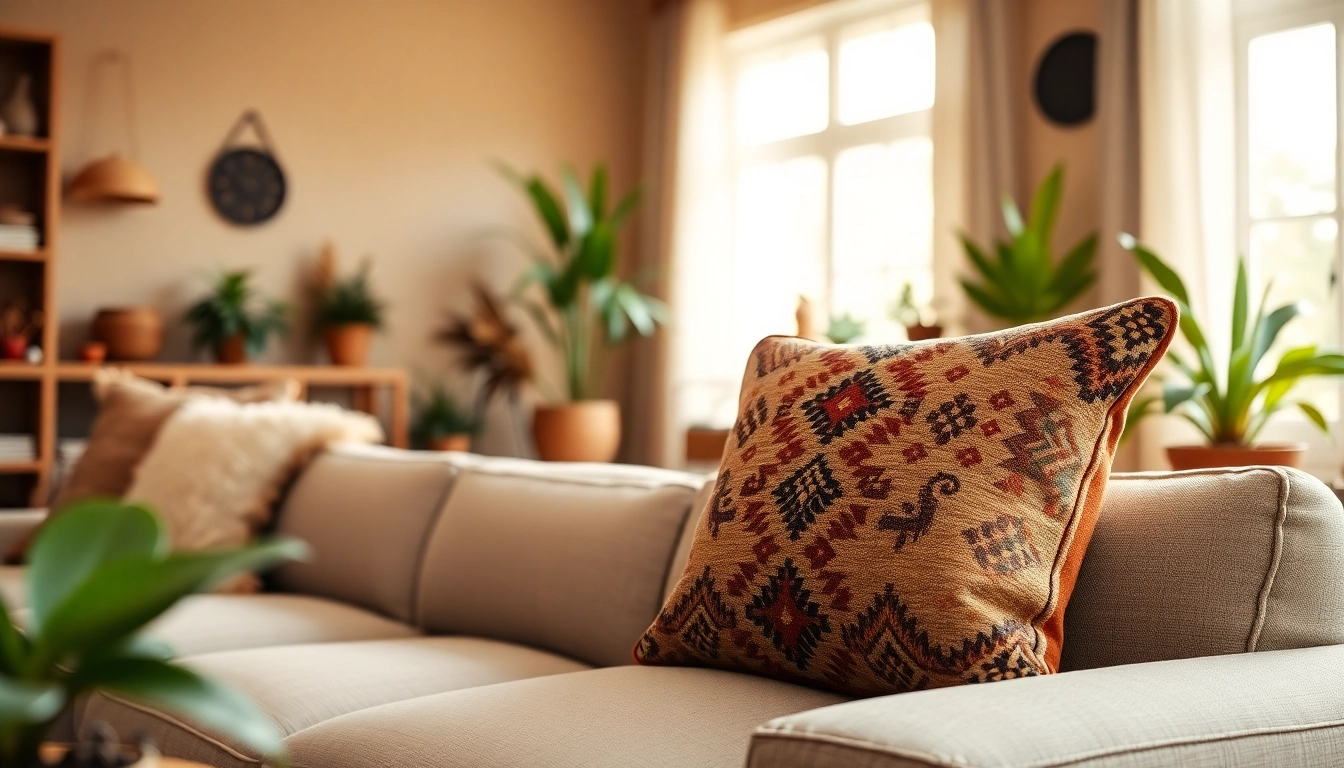Understanding Mali Mudcloth Cushion Covers
Origin and Cultural Significance
Mali mudcloth, also known as “bògòlanfini,” is a traditional textile from Mali, steeped in rich history and cultural significance. Originally used by the Bamana people for various purposes, mudcloth serves as more than just a decorative fabric; it embodies a legacy of storytelling and community. The term “bògòlanfini” translates to “mud from the earth,” which perfectly encapsulates the fabric’s natural origins.
Each piece of mudcloth is hand-dyed and adorned with patterns that reflect the wearer’s identity, achievements, and societal roles. This time-honored craft employs ancient techniques passed down through generations, ensuring that the art of mudcloth remains vibrant and relevant, while simultaneously connecting modern inhabitants to their ancestral roots.
Characteristics of Mudcloth
Mali mudcloth is celebrated for its distinct characteristics and unique textures. It is typically crafted from cotton and dyed using natural methods involving fermented mud and plant materials. This traditional process gives the fabric a robust feel and introduces inconsistencies in color patterns, making each piece one-of-a-kind.
The aesthetics of mudcloth are notable for their earthy tones—deep browns, creamy whites, and sometimes striking blacks—combined to create geometric patterns. These patterns not only serve as visual art but also tell stories that pertain to various cultural significances, including proverbs, rituals, or important life events.
Why Choose Mali Mudcloth?
Choosing Mali mudcloth for home decor, particularly cushion covers, can add a layer of depth and personalization to your living space. The inherent qualities of mudcloth—its durability, attractive aesthetic, and cultural narratives—offer not only visual appeal but also a profound connection to African heritage. In a world where mass production often dulls the uniqueness of decor, authentic mudcloth provides character and a sense of history.
Additionally, using these textiles promotes sustainability. The traditional methods of production are eco-friendly, prioritizing natural dyes and techniques over synthetic processes. Consequently, incorporating Mali Mudcloth Cushion Covers into your decor can be a responsible choice, marrying beauty with environmental consciousness.
Incorporating Mali Mudcloth Cushion Covers into Your Decor
Styling Tips for Different Interiors
Mali mudcloth cushion covers are versatile and can seamlessly blend into various interior styles. For a contemporary space, pairing mudcloth cushions with minimalist furniture creates an intriguing contrast, providing warmth and character. In bohemian-style rooms, a rich mix of textures, including macramé and artisanal pieces, can harmonize beautifully with mudcloth patterns.
For traditional or rustic interiors, consider combining mudcloth with other handmade textiles like woven blankets or rustic wood accents, emphasizing a naturally curated collection. Remember that the contrasting patterns and colors of mudcloth can act as focal points that enhance the overall aesthetic appeal of your space.
Pairing with Other Textiles
When decorating with Mali mudcloth, the key to successful pairing lies in balancing textures and colors. Cozy knits, soft linens, and even leather can create an inviting atmosphere when intertwined with mudcloth cushions. Utilizing neutral-hued fabrics as a backdrop allows the mudcloth’s rich patterns to pop while maintaining overall cohesiveness.
Mixing different textile patterns can also be impactful—consider blending mudcloth with stripe or floral patterns for a dynamic effect. However, ensure that the colors are harmonious; sticking to a cohesive palette will tie the overall design together and ensure a polished look.
Seasonal Decor Ideas
As seasons change, so too can your mudcloth cushion arrangements. In warmer months, opt for brighter, lighter hues within the mudcloth designs to reflect summer’s vibrance, contrasting with airy fabrics like cotton or linen. In autumn and winter, rich earth tones emanate warmth, making mudcloth the perfect choice to create a cozy atmosphere. You can layer mudcloth cushions over heavier throws to enhance texture while maintaining elegance.
For festive occasions, consider incorporating seasonal elements—think warm autumnal colors or rich jewel tones for a winter holiday feel—while still allowing the unique features of mudcloth to shine through.
Care and Maintenance of Mudcloth Products
Cleaning Techniques for Long-Lasting Beauty
To ensure that your Mali mudcloth cushion covers retain their beauty over time, proper care is essential. The best method for cleaning these cushions is hand washing in cold water with a mild detergent. Avoid bleach and harsh chemicals as they can strip the fabric of its natural hues. It’s critical to air dry your mudcloth to prevent any shrinkage or distortion of the fabric.
In addition to washing, regular spot cleaning will resist persistent stains. For smaller spots, a damp cloth with mild soap should suffice—gently dab, do not rub, to avoid damaging the patterns.
Storage Tips to Prevent Damage
When not in use, careful storage of mudcloth products is crucial to prevent fading and wear. Store your cushions in a cool, dry place away from direct sunlight. Using cloth bags instead of plastic can help the fabric breathe and avoid moisture buildup, which could lead to mold.
Ensure that your cushions are completely dry before storage to eliminate any risks of mildew. Additionally, folding them neatly instead of stuffing them can help maintain their shape and design integrity.
Repairing Minor Wear and Tear
Even with diligent care, mudcloth may experience wear and tear. Small holes or frays can often be easily repaired without needing extensive tailoring skills. A simple needle and thread, matched to the fabric, can mend small damages, preserving the item’s character.
If significant damage occurs, consider consulting a professional who understands the intricacies of mudcloth, as they can suggest methods to preserve or restore the fabric without losing its traditional essence.
Shopping for Authentic Mali Mudcloth Cushion Covers
Identifying Quality Mudcloth
When searching for authentic Mali mudcloth, it’s crucial to be informed about what constitutes quality fabric. Authentic mudcloth is handwoven and dyed using traditional methods, which can be identified by the uniqueness in fabric patterns and slight variations in color. Look for imperfections—the hallmark of handmade products that add character and value.
Additionally, quality mudcloth will feel substantial and have a rich texture rather than feeling overly processed or synthetic—always trust your tactile sense as part of your shopping experience.
Best Places to Purchase
Your quest for authentic mudcloth should lead you to reputable stores that specialize in African textiles or artisanal goods. Local artisan shops, craft fairs, and online marketplaces that focus on fair trade are excellent sources. Websites that connect consumers with local artisans directly can provide transparency in sourcing and promote sustainability, which is vital when purchasing unique textiles.
Be cautious with mass-produced alternatives that may mimic the mudcloth style without providing authenticity. Always research suppliers and read reviews before making a purchase.
Cost Considerations and Value
The cost of authentic Mali mudcloth cushion covers can vary significantly based on factors such as size, complexity of patterns, and craftsmanship. While they may be more expensive than their mass-produced counterparts, investing in genuine mudcloth pays off in durability and aesthetic value. Quality pieces can also appreciate in value, making them not just decor but potential heirlooms.
When you consider the unique craftsmanship and cultural heritage embodied in each piece, the expense transitions from a mere decorative cost to an investment in artistry and history.
The Impact of Decor Choices on Wellbeing
Creating a Relaxing Atmosphere
The decor of a home profoundly influences its occupants’ sense of peace and well-being. Mudcloth, with its earthy tones and organic textures, can create a calming environment that promotes relaxation. Textiles have the power to soothe, and the visual warmth of mudcloth can foster a comforting atmosphere conducive to rest and rejuvenation.
Incorporating natural fibers like mudcloth into your living spaces adds to this effect, allowing for a deeper connection to the surroundings. This connection can lead to increased mental well-being and emotional balance within your home.
Enhancing Aesthetic Appeal
Mudcloth cushions introduce a distinct personality to any room, elevating the overall aesthetic appeal of your space. The unique patterns and rich cultural narratives embedded within each piece draw attention and provoke conversation. When art can both beautify and tell a story, it becomes an integral part of the living space’s identity.
By thoughtfully layering mudcloth with other decorative elements, you can craft an engaging visual experience that stimulates not just the eyes but also the mind and spirit.
Connecting with Cultural Artistry
Incorporating Mali mudcloth into your home decor also serves as a medium to honor and recognize diverse cultural expressions. By choosing these authentic pieces, you acknowledge the artistry and heritage of Mali’s textile artisans, supporting their craftsmanship.
An appreciation for cultural artistry can enrich your environment, fostering respect and understanding for global heritage. By introducing these textiles into your home, you engage in a dialogue with centuries of tradition, adding profound value to your decorative choices.



